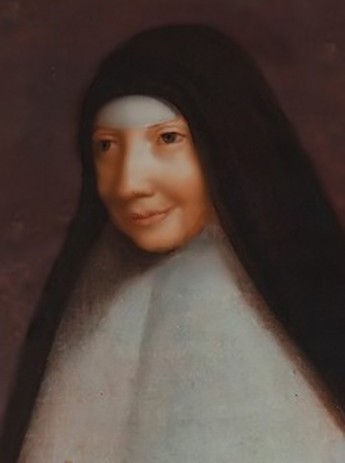Mectildian Jubilee Year: 1614—2014
Ten Reasons Why the Mectildian Jubilee Year Is Significant for the Whole Church

1. Catherine Mectilde de Bar, born at Saint–Dié in Lorraine (France) on 31 December 1614, deserves to be universally known in the Church. She is a woman of the stature of a Gertrude the Great, of a Teresa of Avila, and of a Marie de l’Incarnation. Mother Mectilde’s life and mission are a vivid and compelling demonstration of the role of women in the Church today and in every age. Her writings, steeped in Sacred Scripture and in the liturgical tradition that formed her as a Benedictine nun, reveal a woman of profound human insights and of supernatural wisdom.
2. Mother Mectilde presents the grace of Baptism as being intrinsically ordered to actual participation in the victimhood of Christ by reception of the adorable mysteries of His Body and Blood in Holy Communion. In affirming this, she elucidates with the brightness of her own Eucharistic experience the universal call to holiness articulated in Chapter V of the Second Vatican Council’s Dogmatic Constitution on the Church, Lumen Gentium.
3. The vocational journey of Catherine Mectilde de Bar was marked by unforeseen turns, by sufferings of body and soul, by new beginnings, by constant displacements, and by an immutable stability in the One Thing Necessary. In this, Mother Mectilde speaks to the young men and women of today who must discern their vocations with an immense courage in the midst of uncertainty, movement, and rapid change.
4. The past fifty years have witnessed a massive loss of faith in the real presence of Christ in the Most Holy Eucharist and in Holy Mass as a visible though unbloody sacrifice making present the mystery of Christ, Priest and Victim, in His oblation to the Father. Mother Mectilde’s lucid and fiery Eucharistic doctrine defies every attempt to empty the Mass of its essentially sacrificial character as defined by the Council of Trent.
5. The study of the life and writings of Catherine Mectilde de Bar constitute a precious locus theologicus in which it will be possible to engage certain key teachings of the Council of Trent with the authentic magisterium of the Second Vatican Council in such a way as to arrive at a fruitful synthesis of liturgical continuity, Eucharistic theology, and mystical experience.
6. Mother Mectilde offers a vision of Benedictine life capable of rejuvenating monasticism — especially where it has become institutionalized and listless — with an infusion of Eucharistic vitality. Her commitment to perpetual adoration of the Most Blessed Sacrament corresponds to a contemporary yearning, especially among young people, for a personal, transforming encounter with the Face of God.
7. Catherine Mectilde de Bar’s intimate and cordial relationship with the Blessed Virgin Mary is a model of life–giving Marian piety. The place she gives to Our Lady as the Abbess of her monasteries suggests that every community and family can become, under Mary’s royal protection, and consecrated to her maternal Heart, the cenacle of a continuous Pentecost, a school of apostles and evangelists, and a fruitful womb bearing new life in every generation.
8. Mother Mectilde’s attachment to the sacred liturgy, to the worthy celebration of the Holy Mysteries in an environment marked by beauty, by profound reverence, and by a humble decorum is an invitation to the recovery of what earlier generations held as sacred and great while, at the same time, recognizing every effort at growth and progress duly undertaken in organic continuity, without rupture and, above all, in charity.
9. Catherine Mectilde de Bar lived in a time marked by superstition, sorcery, dalliance with the powers of darkness, blasphemy and sacrilege. Recent distressing events in churches on every continent have demonstrated that global society today has more in common with war–torn 17th century France than one might think. Mother Mectilde bound herself in self–sacrificing love to the perpetrators of such horrible crimes, offering herself as a victim of reparation, that is, as an offering irrevocably made over to God with the intention of supplying for the love and adoration denied Him by those who hate Him and outrage His holiness while, at the same time, praying God to show them mercy and grace them with repentance.
10. Catherine Mectilde de Bar is an icon of the kind of spiritual motherhood needed in the Church today, not only in monastic and religious communities, but in every context where the Church is being born, and born again, of the Eucharist. Ecclesia de Eucharistia. Mother Mectilde demonstrates that the altar itself — the place set apart for the immolation of the Divine Victim — becomes a wellspring of supernatural fecundity in the life of every woman who adhering to the Holy Sacrifice, enters into the victimhood of Christ and, with Him, adores the Father in the Holy Spirit.
